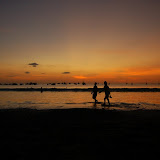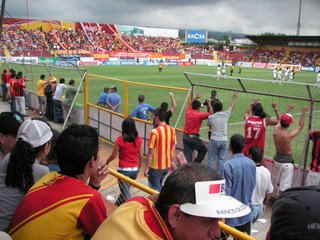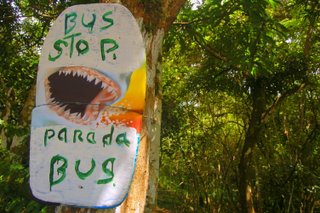By: Bruce
Well, Lisa and I are officially back from our first border run. We went to San Juan del Sur, Nicaragua - which is just north of the Costa Rican border. Anyway, I've decided to split this up into two separate posts: the first post (this post) will be more informational - talking about what the border crossing was like, recommendations, what to look out for, and also how we actually got from San Jose to the tiny surfing town of San Juan del Sur. The second post (which should be up in the next couple of days) will be all about our time in the town, where we stayed, what we liked, didn't like, where to eat, etc etc. Oh and I'll be including pics as I go.
So to begin at the beginning, Lisa and I used the company Tica Bus to take us from San Jose to Rivas, Nicaragua. Really, what you would do is buy a ticket to Managua and get off the bus in Rivas. We got tickets for the 6am bus on Friday morning (I recommend taking as early of a bus as possible) with hopes of arriving in San Juan del Sur sometime that afternoon because we hadn't reserved a hotel room or anything (and had heard that because it is the low season, we wouldn't have to worry about reservations). So yeah, aside from the bus being extremely cold that morning (which is a great trade-off considering the alternative is no A/C), the 4 hours or so that it takes to get to the Costa Rica/Nicaragua border was quite nice and comfortable, and we both slept most of the way. Tica Bus has quality busses. Unfortunately it is the time outside the bus (at the border and upon arriving in Rivas) that can be frustrating, time-consuming, and very very confusing. But hey, that's why this blog is here, and that's why you read it, right?
We got tickets for the 6am bus on Friday morning (I recommend taking as early of a bus as possible) with hopes of arriving in San Juan del Sur sometime that afternoon because we hadn't reserved a hotel room or anything (and had heard that because it is the low season, we wouldn't have to worry about reservations). So yeah, aside from the bus being extremely cold that morning (which is a great trade-off considering the alternative is no A/C), the 4 hours or so that it takes to get to the Costa Rica/Nicaragua border was quite nice and comfortable, and we both slept most of the way. Tica Bus has quality busses. Unfortunately it is the time outside the bus (at the border and upon arriving in Rivas) that can be frustrating, time-consuming, and very very confusing. But hey, that's why this blog is here, and that's why you read it, right?
The Border Crossing: Just to get this out of the way, the border crossings (both into and out of Nicaragua) take time, a lot of time, like 1.5-2 hours. Expect that, and expect the process to involve far more waiting than efficiency. Just keep in mind that border jumps are part of living in Costa Rica, and remember that your destination is THE BEACH. Our friends back home may not have to endure "la frontera" but they also don't get to have weekends at the beach in November or whenever.
Unfortunately there is no "border manuel" that is passed out before you arrive, so you wind up following the herd mentality - and that's okay. Before you get off the bus, the bus driver or an employee of Tica Bus will collect everyone's passports and their customs/declaration forms and he will put them, indescriminantly, in a plain plastic bag. This is very strange to see if you are American. We all want to protect our passports at all cost. That is a ticket home (or out) if necessary, and it is very strange to just hand it over to someone who sticks it in a plastic bag and takes it off the bus. My first thought after handing it over was "gee, I wonder how much he's gonna get off the street for my passport." Either way, its okay, its just how the expedite (and I use that term very loosely) the border crossing process.
So you've given up your passport, and now you're told get off the bus. Why are you getting off? What do you do after you get off? We didn't know, and I doubt more than 10% of the passengers knew - but you do it because everyone else is. Find comfort in the herd. Once we got off the bus, we were disoriented and unsure of where to go or what to do, but we saw a line that had formed from the bus' passengers entering a building, so we decided to join. It's not that easy though, because it's not just you, the passengers, and the border. There's also a mob of men and women all carrying MASSIVE wads of money (see picture) screaming and yelling at you, trying to bargain with you, and take note of this, TRYING TO TAKE ADVANTAGE OF YOU.
 Exchanging Money: Again, like the passport thing, this is going to feel very strange, but you need to do it. The best place/way to exchange your money (I recommend taking dollars becuase you'll get a better rate) is to do so with these renegade money changers while you wait in line. Now you're probably saying, "now Bruce, didn't you just say they are trying to take advantage of you?" Yes I did, but this is where a little bit of pre-trip prep is MANDATORY. Before you leave for Nicaragua, research the Dollar(or Colon) to Cordoba (Nicaragua's currency) exchange rate, and have bench marks for about what you should get for like $20, $50, or whatever amount. This way, when you decide to pay attention to one of the many money changers (all look about as un-official as the other) you will know if they are trying to cheat you and you can move on to someone more honest.
Exchanging Money: Again, like the passport thing, this is going to feel very strange, but you need to do it. The best place/way to exchange your money (I recommend taking dollars becuase you'll get a better rate) is to do so with these renegade money changers while you wait in line. Now you're probably saying, "now Bruce, didn't you just say they are trying to take advantage of you?" Yes I did, but this is where a little bit of pre-trip prep is MANDATORY. Before you leave for Nicaragua, research the Dollar(or Colon) to Cordoba (Nicaragua's currency) exchange rate, and have bench marks for about what you should get for like $20, $50, or whatever amount. This way, when you decide to pay attention to one of the many money changers (all look about as un-official as the other) you will know if they are trying to cheat you and you can move on to someone more honest.
Story:
So Lisa and I did NOT do our research, we only vaguely remembered a friend saying that it was like 19 Cordobas to the dollar. When we stepped off the bus we were unexpectedly bombarded with these screeming money changers. We decided to talk to one once we were in the line and we told him that we wanted to exchange $50 (just to see how this process worked). Then the man whips out his little 30cent calculator and "shows us how he's converting" - I guess to "prove" that the math is right. So he put in 50 and proceeded to divide by 19 while pressing a few buttons very fast, and he came up with 2.61. At that point he says, "okay, I'll give you 261 Cordobas for your 50 dollars." Anyway, long story shorter, I said "let me get this straight, its about 19 Cords to the dollar, we have 50 dollars and you're telling me that that is 261 Cords." He says yes, shows me the calculation again (which, again, involved dividing 50 by 19) and finally I said, sir, that makes NO SENSE WHATSOEVER. I took the calculator and multiplied 50 by 19 (as it should be done) and before I could press enter, he took the calculator back and said "no, no that's not how it's done - I am an official money changer (and he had a makeshift badge to prove it) and that's not how you calculate." At this point, maybe 5 minutes after the convo began, I told him, you know what, I don't think so, no thanks.
Ultimately, Lisa went up and asked an american that we had met who had lived in Nicaragua and he told us we could reasonably expect to get about 350 Cords for $20. So basically that first guy was trying to give us about $18-19 worth of Cords for $50. Thanks but no thanks. We ended up exchanging our money with other people for a rate close to 350cords/$20. Moral of the story? Do your research so that you aren't that ignorant tourist that gets taken advantage of.
Crossing the Border (continued): So with the money changing out of the way, we finished waiting in line, get our passports back, stamped, etc and got back on the bus about 45min-1hr after we got off. Well gee, I was thinking, that wasn't so bad, now we're on our way. Not so fast. After you get back on the bus, you drive about 5 min through the border to the Nicaragua side, stop, and get off the bus again - only this time everyone needs to get ALL their luggage out from under the bus. My recommendation - pack light, it will make life a lot easier, and everyone wheres shorts and t-shirts anyway.  After you get your bags, you stand in yet another line (see picture), this time to pass through customs. There are "random" bag checks at the end of the line, but I put that in quotes because I didn't see a single American/non-central american get searched. They pretty much just wave you through (apparently it's mostly a formality). After that you get back on the bus and about 1.5-2 hours from the time you reached the border, you are finally continuing to Rivas.
After you get your bags, you stand in yet another line (see picture), this time to pass through customs. There are "random" bag checks at the end of the line, but I put that in quotes because I didn't see a single American/non-central american get searched. They pretty much just wave you through (apparently it's mostly a formality). After that you get back on the bus and about 1.5-2 hours from the time you reached the border, you are finally continuing to Rivas.
From Rivas to San Juan del Sur: Like I said earlier, you get a ticket to Managua, but stay alert because you need to get off at the town of Rivas which is only 30-40 min after the border crossing. When you get off the bus, go straight to the Tica Bus office and schedule your return bus (which you've already paid for if you bought round trip tickets - and you SHOULD buy roundtrip if you're planning on coming right back to CR). But stop in the Tica Bus office to make sure you RESERVE SEATS for the ride back. After that, the only thing separating you from both San Juan del Sur and the beach is a taxi ride on quite possibly the most poorly maintained "paved" road I've ever seen (and that's coming from someone living in Costa Rica - the pot-hole paradise).
 Lisa and I had met some fellow gringos on the bus who were also going to SJdelS so we decided to try and split a cab 6 ways. One driver claimed to have a Land Cruiser that would fit all 6 of us and he would charge only $3 per person. You can expect to pay a total of about $15 to get a taxi to SJdelS, so if you split that between a few people it's pretty cheap. Anyway, this experience got sketchy when the driver asked me (the spanish speaker) to go with him to get the Land Cruiser. I gave Lisa my backpack, passport, and anything worth any money, said a prayer, and went with the driver to the mechanic. Yes, the cab that was to take us to San Juan was at the mechanic. The driver told me it was only getting paint touch ups, but when we arrived the mechanic was underneath the SUV WELDING IT. Hardly a touch up... but anyway, que sera sera I suppose. I got in the SUV, met up with the rest of the group and we were on our way.... sort of. About 10 min into the drive we heard a some-what alarming noise and the driver calmly turned to us and said "oh shoot, I forget to put water in the engine" (in other words, it was severly overheated). So he got out, put up the hood (see picture), disappeared, and reemerged with two 2-liters of water that he poured in the engine. After that, all was good (except for the back door bouncing open occasionally - luckily there was no lost luggage) and we arrive in San Juan del Sur with enough time to find a hotel, get some sun-time on the beach, and see a gorgeous sunset (see picture at the end of the post).
Lisa and I had met some fellow gringos on the bus who were also going to SJdelS so we decided to try and split a cab 6 ways. One driver claimed to have a Land Cruiser that would fit all 6 of us and he would charge only $3 per person. You can expect to pay a total of about $15 to get a taxi to SJdelS, so if you split that between a few people it's pretty cheap. Anyway, this experience got sketchy when the driver asked me (the spanish speaker) to go with him to get the Land Cruiser. I gave Lisa my backpack, passport, and anything worth any money, said a prayer, and went with the driver to the mechanic. Yes, the cab that was to take us to San Juan was at the mechanic. The driver told me it was only getting paint touch ups, but when we arrived the mechanic was underneath the SUV WELDING IT. Hardly a touch up... but anyway, que sera sera I suppose. I got in the SUV, met up with the rest of the group and we were on our way.... sort of. About 10 min into the drive we heard a some-what alarming noise and the driver calmly turned to us and said "oh shoot, I forget to put water in the engine" (in other words, it was severly overheated). So he got out, put up the hood (see picture), disappeared, and reemerged with two 2-liters of water that he poured in the engine. After that, all was good (except for the back door bouncing open occasionally - luckily there was no lost luggage) and we arrive in San Juan del Sur with enough time to find a hotel, get some sun-time on the beach, and see a gorgeous sunset (see picture at the end of the post).
Okay, WHEW that was a lot. Lisa, I beleive, is going to write next about the actual town of SJdelS (which was a really great place), finding a hotel, where to eat, what to do, etc etc. So look out for that early next week (this weekend we're going to the beach again - Playa de Coco - so I can get my scuba certification). Thanks for putting up with my writing, and as bad as it may sound, the trip up there (and back) really wasn't bad at all, and the more prepared you are for what to expect, the better it will be.























